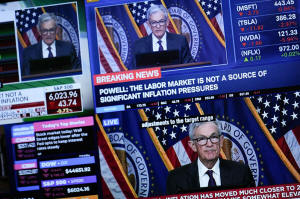Fed hold rates steady, sees inflation as 'elevated,' as Powell declines
comment on Trump
 Send a link to a friend
Send a link to a friend
 [January 30, 2025] By
CHRISTOPHER RUGABER [January 30, 2025] By
CHRISTOPHER RUGABER
WASHINGTON (AP) — The Federal Reserve left its benchmark interest rate
unchanged Wednesday after cutting it three times in a row last year, a
sign of a more cautious approach as the Fed seeks to gauge where
inflation is headed and what policies President Donald Trump may pursue.
In a statement, the Fed said the job market is “solid,” and noted that
the unemployment rate “has stabilized at a low level in recent months.”
The Fed also appeared to toughen its assessment of inflation, saying
that it “remains somewhat elevated.” Both a healthier job market and
more stubborn inflation typically would imply fewer Fed rate cuts in the
coming months.
In a news conference Wednesday, Fed Chair Jerome Powell largely
deflected questions about recent comments from President Trump,
including one from last week, when Trump said he would lower oil prices
and then “demand” lower rates. He also said he would speak with Powell
about it.
“I'm not going to have any response or comment on whatever the president
said,” Powell said. Asked if Trump had communicated his desire for lower
rates directly to Powell, the Fed chair said he had “no contact.”
Regarding the Fed's key rate, Powell conveyed a more deliberate
approach, noting that the economy is mostly healthy — the unemployment
rate is a low 4.1% and growth topped 3% at an annual rate in the fall.
“With ... the economy remaining strong, we do not need to be in a hurry
to adjust our policy stance," Powell said.

Asked about the potential impact of the sharp policy changes Trump has
proposed regarding tariffs, immigration, tax cuts, and deregulation,
Powell said Fed policymakers are “waiting to see which policies are
enacted.”
“We don’t know what will happen,” he added. “We need to let those
policies be articulated before we can even begin to make a plausible
assessment of what their implications for the economy will be."
Kathy Bostjancic, chief economist at Nationwide Financial, said Powell's
comments suggest the Fed won't cut rates again until the middle of this
year.
“We are all in wait and see mode, including the Fed,” she said.
The Fed reduced its rate last year to 4.3% from 5.3%, in part out of
concern that the job market was weakening. Hiring had slowed in the
summer and the unemployment rate ticked up, leading Fed officials to
approve an outsized half-point cut in September. Yet hiring rebounded
last month and the unemployment rate declined slightly, to a low 4.1%.
Powell has said it is harder to gauge where inflation is headed, in part
because of increased uncertainty around what policies Trump will adopt
and how quickly they will affect the economy. Higher tariffs and tax
cuts could push inflation higher, while deregulation could possibly
reduce it.
The Fed typically keeps interest rates high to slow borrowing and
spending and cool inflation.
In December, Fed officials signaled they may reduce their rate just
twice more this year. Goldman Sachs economists believes those cuts won’t
happen until June and December.
In November, inflation was just 2.4%, according to the Fed’s preferred
measure, not far from its 2% target. But excluding the volatile food and
energy categories, core prices rose a more painful 2.8% from a year
earlier. The Fed pays close attention to core prices because they are
often a better guide to inflation’s future path.
[to top of second column] |

Screens display a news conference by Federal Reserve Chair Jerome
Powell on the floor of the New York Stock Exchange in New York,
Wednesday, Jan. 29, 2025. (AP Photo/Seth Wenig)
 Powell said the Fed wants to see
“real progress on inflation or ... some weakness in the labor market
before we before we consider” making further cuts.
In a post to his Truth Social account late Wednesday, Trump
criticized the Fed for failing to curtail inflation, saying he would
do so by “unleashing American Energy production, slashing
Regulation, rebalancing international Trade, and reigniting American
Manufacturing.”
During the news conference, Powell was also asked about Trump's
executive orders intended to limit diversity, equity, and inclusion
programs, which Powell has previously backed.
“As has been our practice over many administrations, we are working
to align our policies with the executive orders as appropriate and
consistent with applicable law,” he said.
Powell also addressed the Fed's decision earlier this month to leave
the Network for Greening the Financial System, an international
group that sought to address how financial regulators and banks
could address climate change. The Fed had joined the group in 2020.
Powell said the group's goals had expanded to things like addressing
biodiversity that were “way beyond” the Fed's mission.
“I think that the the activities of the NGFS are not a good fit for
the Fed, given our current mandate,” he said.
Most other central banks in developed countries are cutting their
interest rates. The European Central Bank, for example, is widely
expected to reduce borrowing costs at its next meeting on Thursday.
The Bank of Canada said Wednesday it has also cut its rate, and the
Bank of England is also expected to do so next month.
The Bank of Japan, however, is actually raising its rate from a
rock-bottom level. Japan has finally experienced some inflation
after decades of slower growth and bouts of deflation.
A Fed rate cut in March is still possible, though financial markets'
futures pricing puts the odds of that happening at under 20%.
As a result, American households and businesses are unlikely to see
much relief from high borrowing costs anytime soon. The average rate
on a 30-year mortgage slipped to just below 7% last week after
rising for five straight weeks. The costs of borrowing money have
remained high economywide even after the Fed reduced its benchmark
rate.

That is because investors expect healthy economic growth and
stubborn inflation will forestall future rate cuts. They recently
bid up the 10-year Treasury above 4.80%, its highest level since
2023.
Powell acknowledged that higher rates have made it harder for many
would-be homebuyers to afford a home, and said that would likely
continue.
The stock and bond markets had muted reactions to the Fed’s
decision, which was widely expected.
___
Associated Press Writer Josh Boak contributed to this report.
All contents © copyright 2025 Associated Press. All rights reserved |